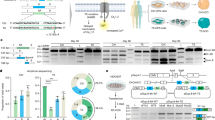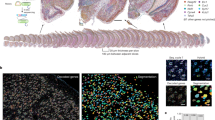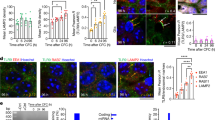Abstract
Neurons are continuously generated from stem cells in discrete regions in the adult mammalian brain. We found that ependymal cells lining the lateral ventricles were quiescent and did not contribute to adult neurogenesis under normal conditions in mice but instead gave rise to neuroblasts and astrocytes in response to stroke. Ependymal cell quiescence was actively maintained by canonical Notch signaling. Inhibition of this pathway in uninjured animals allowed ependymal cells to enter the cell cycle and produce olfactory bulb neurons, whereas forced Notch signaling was sufficient to block the ependymal cell response to stroke. Ependymal cells were depleted by stroke and failed to self-renew sufficiently to maintain their own population. Thus, although ependymal cells act as primary cells in the neural lineage to produce neurons and glial cells after stroke, they do not fulfill defining criteria for stem cells under these conditions and instead serve as a reservoir that is recruited by injury.
This is a preview of subscription content, access via your institution
Access options
Subscribe to this journal
Receive 12 print issues and online access
$209.00 per year
only $17.42 per issue
Buy this article
- Purchase on Springer Link
- Instant access to full article PDF
Prices may be subject to local taxes which are calculated during checkout








Similar content being viewed by others
References
Mirzadeh, Z., Merkle, F.T., Soriano-Navarro, M., Garcia-Verdugo, J.M. & Alvarez-Buylla, A. Neural stem cells confer unique pinwheel architecture to the ventricular surface in neurogenic regions of the adult brain. Cell Stem Cell 3, 265–278 (2008).
Doetsch, F., Caille, I., Lim, D.A., Garcia-Verdugo, J.M. & Alvarez-Buylla, A. Subventricular zone astrocytes are neural stem cells in the adult mammalian brain. Cell 97, 703–716 (1999).
Johansson, C.B. et al. Identification of a neural stem cell in the adult mammalian central nervous system. Cell 96, 25–34 (1999).
Meletis, K. et al. Spinal cord injury reveals multilineage differentiation of ependymal cells. PLoS Biol. 6, e182 (2008).
Weigmann, A., Corbeil, D., Hellwig, A. & Huttner, W.B. Prominin, a novel microvilli-specific polytopic membrane protein of the apical surface of epithelial cells, is targeted to plasmalemmal protrusions of non-epithelial cells. Proc. Natl. Acad. Sci. USA 94, 12425–12430 (1997).
Ferri, A.L. et al. Sox2 deficiency causes neurodegeneration and impaired neurogenesis in the adult mouse brain. Development 131, 3805–3819 (2004).
Sakakibara, S. et al. RNA-binding protein Musashi family: roles for CNS stem cells and a subpopulation of ependymal cells revealed by targeted disruption and antisense ablation. Proc. Natl. Acad. Sci. USA 99, 15194–15199 (2002).
Doetsch, F., Garcia-Verdugo, J.M. & Alvarez-Buylla, A. Cellular composition and three-dimensional organization of the subventricular germinal zone in the adult mammalian brain. J. Neurosci. 17, 5046–5061 (1997).
Ellis, P. et al. SOX2, a persistent marker for multipotential neural stem cells derived from embryonic stem cells, the embryo or the adult. Dev. Neurosci. 26, 148–165 (2004).
Götz, M. & Huttner, W.B. The cell biology of neurogenesis. Nat. Rev. Mol. Cell Biol. 6, 777–788 (2005).
Spassky, N. et al. Adult ependymal cells are postmitotic and are derived from radial glial cells during embryogenesis. J. Neurosci. 25, 10–18 (2005).
Gregg, C. & Weiss, S. Generation of functional radial glial cells by embryonic and adult forebrain neural stem cells. J. Neurosci. 23, 11587–11601 (2003).
Taylor, M.D. et al. Radial glia cells are candidate stem cells of ependymoma. Cancer Cell 8, 323–335 (2005).
Zhang, R.L. et al. Stroke induces ependymal cell transformation into radial glia in the subventricular zone of the adult rodent brain. J. Cereb. Blood Flow. Metab. 27, 1201–1212 (2007).
Coskun, V. et al. CD133+ neural stem cells in the ependyma of mammalian postnatal forebrain. Proc. Natl. Acad. Sci. USA 105, 1026–1031 (2008).
Capela, A. & Temple, S. LeX/ssea-1 is expressed by adult mouse CNS stem cells, identifying them as nonependymal. Neuron 35, 865–875 (2002).
Louvi, A. & Artavanis-Tsakonas, S. Notch signaling in vertebrate neural development. Nat. Rev. Neurosci. 7, 93–102 (2006).
Gaiano, N., Nye, J.S. & Fishell, G. Radial glial identity is promoted by Notch1 signaling in the murine forebrain. Neuron 26, 395–404 (2000).
Ishibashi, M. et al. Persistent expression of helix-loop-helix factor HES-1 prevents mammalian neural differentiation in the central nervous system. EMBO J. 13, 1799–1805 (1994).
Mizutani, K. & Saito, T. Progenitors resume generating neurons after temporary inhibition of neurogenesis by Notch activation in the mammalian cerebral cortex. Development 132, 1295–1304 (2005).
Bajocchi, G., Feldman, S.H., Crystal, R.G. & Mastrangeli, A. Direct in vivo gene transfer to ependymal cells in the central nervous system using adenoviral vectors. Nat. Genet. 3, 229–234 (1993).
Davidson, B.L. & Bohn, M.C. Recombinant adenovirus: a gene transfer vector for study and treatment of CNS disease. Exp. Neurol. 144, 125–130 (1997).
Akli, S. et al. Transfer of a foreign gene into the brain using adenovirus vectors. Nat. Genet. 3, 224–228 (1993).
Ostrowski, L.E., Hutchins, J.R., Zakel, K. & O'Neal, W.K. Targeting expression of a transgene to the airway surface epithelium using a ciliated cell–specific promoter. Mol. Ther. 8, 637–645 (2003).
Lim, L., Zhou, H. & Costa, R.H. The winged helix transcription factor HFH-4 is expressed during choroid plexus epithelial development in the mouse embryo. Proc. Natl. Acad. Sci. USA 94, 3094–3099 (1997).
Blatt, E.N., Yan, X.H., Wuerffel, M.K., Hamilos, D.L. & Brody, S.L. Forkhead transcription factor HFH-4 expression is temporally related to ciliogenesis. Am. J. Respir. Cell Mol. Biol. 21, 168–176 (1999).
Soriano, P. Generalized lacZ expression with the Rosa26-cre reporter strain. Nat. Genet. 21, 70–71 (1999).
Lindvall, O. & Kokaia, Z. Neurogenesis following stroke affecting the adult brain. in Adult Neurogenesis (eds. Gage, F.H., Kempermann, G. & Song, H.) (Cold Spring Harbor Laboratory Press, Cold Spring Harbor, New York, 2008).
Barnabe-Heider, F. et al. Genetic manipulation of adult mouse neurogenic niches by in vivo electroporation. Nat. Methods 5, 189–196 (2008).
Sang, L., Coller, H.A. & Roberts, J.M. Control of the reversibility of cellular quiescence by the transcriptional repressor HES1. Science 321, 1095–1100 (2008).
Wei, Y., Yu, L., Bowen, J., Gorovsky, M.A. & Allis, C.D. Phosphorylation of histone H3 is required for proper chromosome condensation and segregation. Cell 97, 99–109 (1999).
Lledo, P.M., Alonso, M. & Grubb, M.S. Adult neurogenesis and functional plasticity in neuronal circuits. Nat. Rev. Neurosci. 7, 179–193 (2006).
Winner, B., Cooper-Kuhn, C.M., Aigner, R., Winkler, J. & Kuhn, H.G. Long-term survival and cell death of newly generated neurons in the adult rat olfactory bulb. Eur. J. Neurosci. 16, 1681–1689 (2002).
Androutsellis-Theotokis, A. et al. Notch signaling regulates stem cell numbers in vitro and in vivo. Nature 442, 823–826 (2006).
Dor, Y. & Melton, D.A. Facultative endocrine progenitor cells in the adult pancreas. Cell 132, 183–184 (2008).
Dor, Y., Brown, J., Martinez, O.I. & Melton, D.A. Adult pancreatic beta-cells are formed by self-duplication rather than stem-cell differentiation. Nature 429, 41–46 (2004).
Simon, A. & Frisen, J. From stem cell to progenitor and back again. Cell 128, 825–826 (2007).
Nakagawa, T., Nabeshima, Y. & Yoshida, S. Functional identification of the actual and potential stem cell compartments in mouse spermatogenesis. Dev. Cell 12, 195–206 (2007).
Levy, V., Lindon, C., Harfe, B.D. & Morgan, B.A. Distinct stem cell populations regenerate the follicle and interfollicular epidermis. Dev. Cell 9, 855–861 (2005).
Ito, M. et al. Stem cells in the hair follicle bulge contribute to wound repair, but not to homeostasis of the epidermis. Nat. Med. 11, 1351–1354 (2005).
Xu, X. et al. Beta cells can be generated from endogenous progenitors in injured adult mouse pancreas. Cell 132, 197–207 (2008).
Tanigaki, K. et al. Notch–RBP-J signaling is involved in cell fate determination of marginal zone B cells. Nat. Immunol. 3, 443–450 (2002).
Consiglio, A. et al. Robust in vivo gene transfer into adult mammalian neural stem cells by lentiviral vectors. Proc. Natl. Acad. Sci. USA 101, 14835–14840 (2004).
Hara, H., Huang, P.L., Panahian, N., Fishman, M.C. & Moskowitz, M.A. Reduced brain edema and infarction volume in mice lacking the neuronal isoform of nitric oxide synthase after transient MCA occlusion. J. Cereb. Blood Flow Metab. 16, 605–611 (1996).
Acknowledgements
We are grateful to U. Lendahl, O. Hermanson, A. Simon and members of the Frisén laboratory for valuable discussions; L. Ostrowski for the Foxj1 promoter construct; T. Li for antibodies to Crocc; U. Lendahl for N1IC and 12× Rbpj-dsgfp cDNA; O. Bergmann for virus injections; and M-L. Spångberg and K. Hamrin for technical assistance. This study was supported by grants from the Swedish Research Council, the Swedish Cancer Society, the Foundation for Strategic Research, the Juvenile Diabetes Research Foundation, the Karolinska Institute, Tobias Stiftelsen and the European Commission Framework VI Programme, EuroStemCell and StemStroke. M.C. and E.E. are supported by postdoctoral fellowships from the Swedish Brain Foundation (Hjärnfonden), C.G. by a postdoctoral fellowship from the Wenner-Gren Foundation and F.B.-H. by postdoctoral fellowships from the Canadian Institutes of Health Research and the Christopher and Dana Reeve Foundation.
Author information
Authors and Affiliations
Contributions
M.C. and K.M. designed the study, carried out viral injections, analyzed and documented the Rbpj ablation and stroke experiments and wrote the paper. C.G. carried out viral injections and analyzed and documented the stroke experiments. V.D. conducted the stroke experiments. E.E. performed ultrastructural analyses. K.T. helped with the initial Rbpj ablation experiments. M.A. produced lentivirus. F.B.-H. carried out electroporation. M.S.Y.Y. contributed to the documentation of neuronal maturation in the olfactory bulb. L.N. supervised the lentivirus production. T.H. provided conditional Rbjp mice. Z.K. designed and analyzed the stroke experiments. O.S. designed and performed the ultrastructural analyses. R.M.C. initiated the study, carried out viral injections, analyzed and documented the Rbpj ablation experiments and the expression of components of the Notch pathway. O.L. designed and supervised the stroke experiments and wrote the paper. J.F. designed and supervised the study and wrote the paper.
Corresponding author
Supplementary information
Supplementary Text and Figures
Supplementary Figures 1–11 (PDF 4034 kb)
Rights and permissions
About this article
Cite this article
Carlén, M., Meletis, K., Göritz, C. et al. Forebrain ependymal cells are Notch-dependent and generate neuroblasts and astrocytes after stroke. Nat Neurosci 12, 259–267 (2009). https://doi.org/10.1038/nn.2268
Received:
Accepted:
Published:
Issue Date:
DOI: https://doi.org/10.1038/nn.2268
This article is cited by
-
Dexamethasone-Induced Modifications of the Intracerebral Hemorrhage-Related Reactions of Astrocytes in Rats
Neurophysiology (2024)
-
Outcomes of the 2019 hydrocephalus association workshop, "Driving common pathways: extending insights from posthemorrhagic hydrocephalus"
Fluids and Barriers of the CNS (2023)
-
The activation of dormant ependymal cells following spinal cord injury
Stem Cell Research & Therapy (2023)
-
Heterozygous FOXJ1 Mutations Cause Incomplete Ependymal Cell Differentiation and Communicating Hydrocephalus
Cellular and Molecular Neurobiology (2023)
-
Immune cell compartmentalization for brain surveillance and protection
Nature Immunology (2021)



